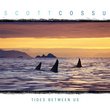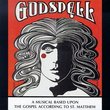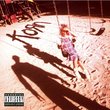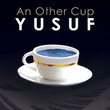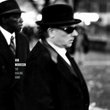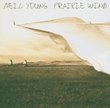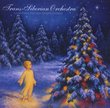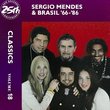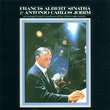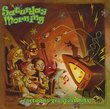| All Artists: Robert Fripp, Brian Eno Title: Essential Fripp & Eno Members Wishing: 9 Total Copies: 0 Label: Caroline Release Date: 3/11/1994 Genres: Dance & Electronic, Alternative Rock, Special Interest, New Age, Pop, Rock Styles: Ambient, Electronica, Experimental Music, Progressive, Progressive Rock, Rock Guitarists Number of Discs: 1 SwapaCD Credits: 1 UPCs: 017046188623, 017046188647, 0724383904556, 724383904525 |
Search - Robert Fripp, Brian Eno :: Essential Fripp & Eno
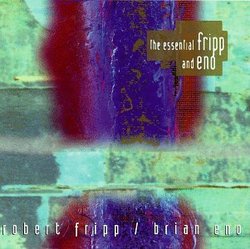 | Robert Fripp, Brian Eno Essential Fripp & Eno Genres: Dance & Electronic, Alternative Rock, Special Interest, New Age, Pop, Rock
|
Larger Image |
CD DetailsSimilar CDs
Similarly Requested CDs
|
CD ReviewsWho put this together? spiral_mind | Pennsylvania | 02/02/2001 (4 out of 5 stars) "No Pussyfooting. Evening Star. Two of the first (and finest) ambient recordings ever made, records that paved the way for many to follow. Eno's ambient works (and many others), Fripp's Frippertronics and Soundscapes, all have their root here. Why, then, an 'essential' collection from only two records? No Pussyfooting is included in its entirety, and it hasn't dated in the least since 1973. "Heavenly Music Corporation" presents waves of Fripp's dreamlike guitar endlessly whirling and flowing, perfect for talking or sleeping or relaxing or, well, just about anything. "Swastika Girls" takes us to a peaceful sunlit temple in the middle of nowhere. The keyboards and effects trickle and shimmer while varying guitar tones ride the waves. A universal and timeless album, one of the few I could recommend to just about anyone. Two Evening Star tracks are also included, but the other 36 minutes of that album are just as essential - especially "An Index of Metals." And so we come to the usual marketing gimmick for this sort of compilation: the previously unreleased tracks. In this case it sounds like an ambient Fripp/Eno outtake given the Puff Daddy treatment by an amateur sound engineer working with substandard equipment in somebody's garage. There's an ambient tune in there somewhere, but it's blended with cheap, cheesy electronic drum sounds and inane voice samples. Why? This is the kind of thing I'd imagine them coming up with at 2 a.m. after an unproductive day, burned out and trying to do something for a laugh. The four variations on this one track fit with the rest of the music about as well as Garth Brooks sitting in with the Philadelphia Symphony. This album basically replaces No Pussyfooting, but it's badly misnamed. Between those first two albums you'd have all the essential stuff; if you pick up this one, be ready to program out those last four tracks." The Essential Fripp and Eno. Louie Bourland | Garden Grove CA | 09/01/2003 (5 out of 5 stars) "The musical experiments of King Crimson guitarist/founder Robert Fripp and electronic music pioneer/former Roxy Music member Brian Eno were definitely groundbreaking when they were released in the early to mid '70s. The pair released two albums, 1973's "No Pussyfooting" and 1975's "Evening Star", which paved the way for ambient and so-called 'new age' music. With the 1994 compilation "The Essential Fripp and Eno", we are offered an excellent sampling of the noise that these two musicians made so long ago. The compilation includes the "No Pussyfooting" album in its entirety plus two tracks from "Evening Star" and the previously unreleased "Healthy Colours Parts 1-4" which was recorded in 1978. "No Pussyfooting's" "The Heavenly Music Corporation" and "Swastika Girls" consist mostly of Robert Fripp performing fluid sustained guitar lines which are manipulated by Brian Eno using tape machines and a primitive synthesizer. It's beautiful and frantic at the same time. "Wind on Water" and the title track from "Evening Star" have a more quieter surreal mood to them. "Evening Star" in particular has beautiful melodic parts with simplistic piano and guitar lines. The unreleased "Healthy Colours" suite is quite different from the previous music made by the duo. Each of the four sections consist of repeated rhythm guitar patterns, a bouncy elementary synthesizer line and various tapeloops of speech all set to a primitive drum machine. This music is quite minimalistic and dry-sounding. All together, "The Essential Fripp and Eno" covers the basics of what Robert Fripp and Brian Eno did as a musical force. Since they only released two albums together, I personally think that releasing this as a 2-disc set with "Healthy Colours" tacked onto the end would have been a better idea (The lenghty "Index of Metals" from "Evening Star" is an essential piece in my opinion). However, I have no complaints with the way this compilation is put together. The sound quality is stellar on this CD and so is the music. Here's hoping that Robert and Brian will reunite for something new real soon." Lost luggage loteq | Regensburg | 12/11/2000 (3 out of 5 stars) ""The essential" is not an adequate anthology of the duo's mid-'70s collaborations, but it does manage to gather some of the better pieces of their output. I tend to agree with one of the prior reviewers who said that this album should be taken as an alternative to 1973's "No pussyfooting"; I think that "The essential" better should be labelled as "No pussyfooting (Remastered) + 6 bonus tracks". This compilation was released to coincide with Eno's mammoth box sets "Eno:Instrumental"(including a 7-minute edit of "An index of metals") and "Eno:Vocal" back in 1994, two three-disc sets which provide an excellent overview of Eno's entire career, so it's probably meant as an introduction for people who don't want to buy the individual albums of Eno and Fripp. "The essential" opens with the most complex track, the 21-minute "The heavenly..", a piece which introduces the then-innovative technique of tape loop manipulation. Although the sounds are quite static and not always particularly melodic, the hypnotic nature of the music and Fripp's long-stretched solo textures put this track over the top. The 18 1/2-minute "Swastika girls" is similar in approach, yet the guitar parts are more aggressive, sometimes shifting into discordant riffs and piercing feedback. As innovative and groundbreaking this sort of ambient music was, the fact still remains that these two aforementioned pieces have too few ideas for their length. If you have already listened to albums of '90s ambient artists like Main and Seefeel and to Fripp's/Eno's more recent work, you know what I mean. Nevertheless, the tracks which are taken from the duo's second outing, "Evening star", are still very listenable and show a refinement of the methods used on "No pussyfooting". The aptly titled "Wind on water" features warm background textures which are joined by glittering layers of treated guitar/synths, creating a baffling yet thoroughly compelling 'electronic listening' piece. The obvious stand-out cut on this disc is the 7 3/4-minute "Evening star", perhaps one of the greatest ambient/new age tracks ever made. The scene is carefully built up by Fripp's guitar sounds - rhythm guitar on the left stereo channel, three-note picking on the right one, and various feedback whines/drones between the two channels - before Eno adds some atmospheric synths and romantic piano lines. In complete contrast to this great track is the closing quartet of soundscapes, the previously unreleased "Healthy colours": Although this piece is divided into four parts, it smashes into your skull with more than 23 minutes of exactly the same thing - a muddy amalgam of swampy percussion (not dissimilar to that on the Eno/Lanois/Brook collaboration "Hybrid"), thin guitar chords, meandering bass drones, and vocal samples which are so childish that they become annoying very quickly. To my ears, it almost seems like self-parody. "Healthy colors" may have been palatable if Eno/Fripp had supported this piece with a melody or a hook every now and then, but it's so discordant and unmemorable that it must be considered as self-indulgent garbage. Apart from this grave misstep, I'd really recommend this album if you're interested in the roots of ambient/new age music."
|

 Track Listings (8) - Disc #1
Track Listings (8) - Disc #1